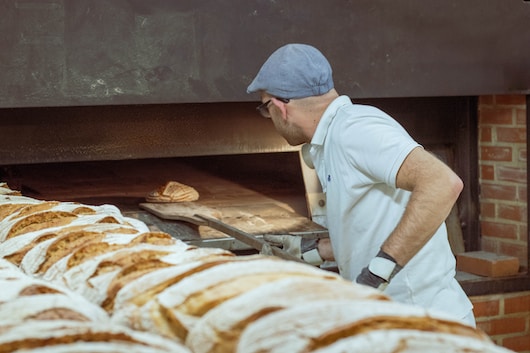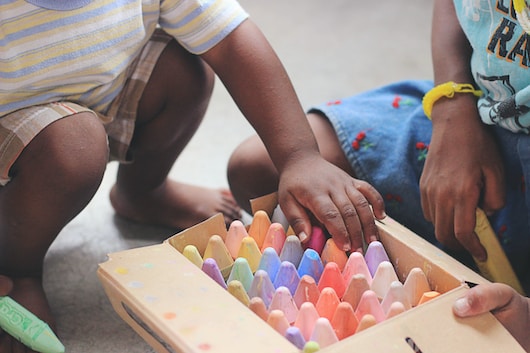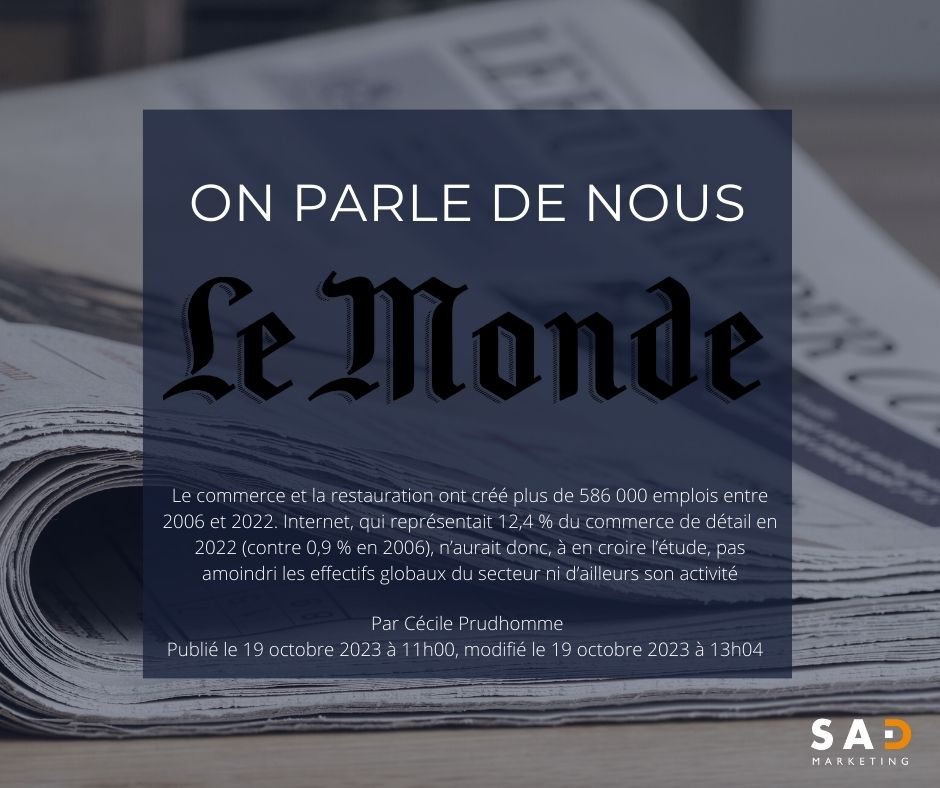06/06/24
Qatar and its economic ambitions
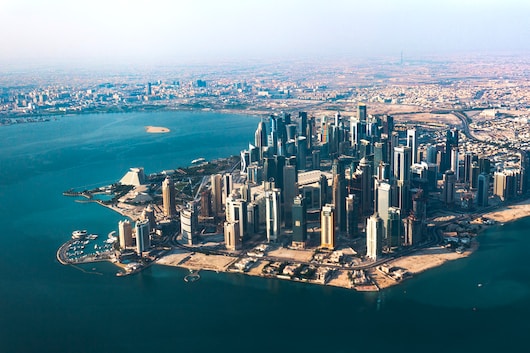
Situation
Situated on a small peninsula jutting into the Persian Gulf and connected to the Arabian Peninsula to the south, where it shares a land border with Saudi Arabia, Qatar has nearly 3 million inhabitants.
With 1.2 million residents, its capital, Doha, is the largest city followed by Al Rayyan with 800,000. These two cities alone concentrate more than 70% of the population.

The next most populated municipalities are Al Wakrah with 265,000 inhabitants and Al Khor with 140,000 inhabitants.
In the coming years, the population growth rate is expected to continue, reaching 3.5 million inhabitants by 2035.
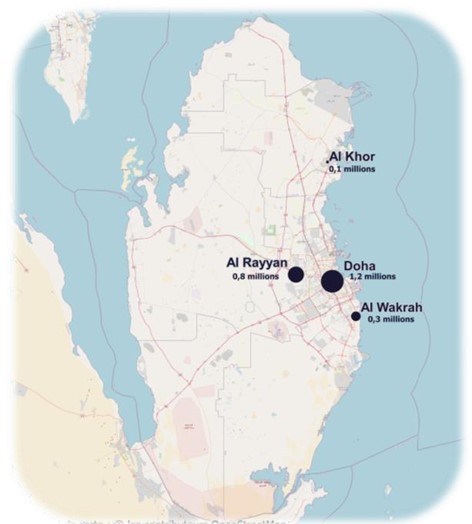
Population

In Qatar, only one in four people is a woman. This can be explained by the high immigration rate linked to labor. The construction sector is the main employer in Qatar, primarily hiring men.
Due to work-related immigration, the population is also young:
| 73% | 1% |
| Population between 25 and 64 years | Population over 65 years |
Migrants from the Gulf region, India, Nepal, Pakistan, and Bangladesh are sought to provide cheap labor.
Qataris are only the 4th largest nationality represented in Qatar, far behind Indians, Bangladeshis, and Nepalis.
| Nationality | Population | Percentage of Population |
| Indian | 700,000 | 22% |
| Bangladeshi | 400,000 | 13% |
| Nepali | 400,000 | 13% |
| Qatari | 333,000 | 10% |
| Egyptian | 300,000 | 9% |
| French | 5,500 | 0% |
Massive Consumption Inequalities Between Qataris and Non-Qataris
Qatar is one of the richest countries per capita in the world.
It is the fifth largest producer of natural gas in the world. It is also a medium-sized oil producer.

Its residents spend 13% less than the French, although there is a huge gap between nationalities: a Qatari household spends 4 times more than a non-Qatari household, and much more than a French household.


Households in Qatar spend more than French households in the sectors of food, dining, personal equipment, and beauty/health (39% vs. 34%, 16% vs. 13%, 16% vs. 8%, 11% vs. 9%, respectively), while they spend less in the sectors of home equipment and culture/leisure (9% vs. 18% and 9% vs. 17%, respectively).
Tourism and Sports: Two Pillars of Development
The country’s economic goal is diversification through the National Vision 2030 strategy. The power levers the country aims to activate are varied (new technologies, media, stock market…), but the two main ones are tourism and sports.
Pre-Covid, Qatar welcomed more than 2 million tourists who spent an average of 3.5 nights in the country. Since then, tourist flows have declined.
Diplomatic and economic influence through sports has been ongoing for many years. Qatar has successfully obtained the organization of the following events:
- 2006 Asian Games
- 2015 World Handball Championships
- 2016 Road World Championships
- 2018 Artistic Gymnastics World Championships
- 2019 World Athletics Championships
- 2022 World Cup
Qatar’s expenditures for hosting the World Cup are staggering: 210 billion euros.
A large part of the World Cup infrastructure costs is part of the Qatar 2030 plan, which includes the construction of hotels, underground transportation, and airports.
The construction costs for the new stadiums are estimated at nearly 10 billion euros. Of the eight stadiums hosting matches, only one was in service before the World Cup was awarded to Qatar in 2010.
Qatar has also developed in sports medicine and has become a renowned rehabilitation center for athletes from around the world.

A Blockade that Boosted “Made in Qatar”
From June 2017 to 2021, Saudi Arabia, the United Arab Emirates (UAE), Bahrain, and Egypt cut all commercial and political relations with Qatar in retaliation for the country’s refusal to align with their diplomatic stance (anti-Iran and anti-Muslim Brotherhood).
Qatar had to expand its trade relations with Iran, Turkey, and Russia, and promoted its own industries to overcome import limitations.
In January 2020, Al Meera, Qatar’s largest retail chain, announced that it would offer more “Made in Qatar” products in its supermarkets and hypermarkets to support small and medium-sized enterprises, especially those in agriculture and agri-food. Along with the French Géant, Al Meera operates over fifty hypermarkets and supermarkets in Qatar and plans further expansions.
Local supermarkets and international chains continue to grow their activities, and the sector is currently expanding.
The main players operating in the sector:

Retail Withstood the Pandemic, but Mall Overdensity Looms
30 Malls
655 m² per 1,000 inhabitants
2 million m² of rental area
80% in the Doha metropolitan area
Super-regional malls (74,000 m² and more) = 52% of the total gross leasable area:
Doha Festival City (the world’s largest mall upon its opening)
Mall of Qatar
The Pearl
Doha City Center
Doha Mall
Villagio
Market players are facing a potential oversupply of retail spaces. Rents in the most popular malls in Doha, ranging from 50 to 65 euros/m²/month, have dropped since Covid.
At the beginning of 2022, 20% of retail space in Doha malls was vacant. Some medium-sized malls have up to 30% vacancy.
Two new malls still opened in 2021 and 2022: Abu Sidra Mall and Place Vendôme, themed around Paris, with all the luxury French brands, of course.
A new mall will open in 2023: Marina Plaza in the Lusail district. Other developments will follow: Doha Oasis, 04 Mall, Waddan Mall, Commercial Boulevard, and the MENA district in the Doha Port.
The Rise of “Made in Qatar” Luxury, for Some…
The high purchasing power of Qatari citizens has maintained strong performance in this segment, even as the general retail market showed a slowdown.
Qatar is considered the fastest-growing luxury market in the world.
It holds a majority stake in the Italian fashion brand Valentino as well as in Harrods in London and Printemps in Paris.
The segment is not only dominated by well-known international brands like Versace, Gucci, Dior, Cartier, and Armani, but local brands have also found success.
QELA, the country’s luxury brand launched in partnership with Qatar Luxury Group, and Pharmakeia, a boutique selling organic beauty and wellness products, are now popular with locals and foreigners alike.
The Hidden Cost of Economic Boom
More than 6,750 migrant workers have died in Qatar since the World Cup was awarded.
According to the director of FairSquare*, this figure is likely underestimated. Many of the migrant workers who have died since 2011 were in Qatar to work on World Cup infrastructure.
To be employed in Qatar, these workers have to pay recruitment fees that can exceed 3,000 euros.
Despite testimonies from workers and their families about working conditions, the Qatari government classifies 70% of these deaths as natural, without conducting autopsies.
*NGO specializing in labor rights in the Middle East
France’s Many Economic Interests in Qatar
Despite being heavily criticized for its human rights and environmental violations, the World Cup remains a driver of economic interests for France in Qatar.
More than 100 French companies are present there.
In retail, Carrefour is the market leader with 10 hypermarkets and supermarkets. Monoprix is also well-established.
Many French brands are also present in all non-food activities.
Galeries Lafayette opened in 2019 and Printemps opened its first store abroad, covering 40,000m2 in the new high-end Doha Oasis complex.


